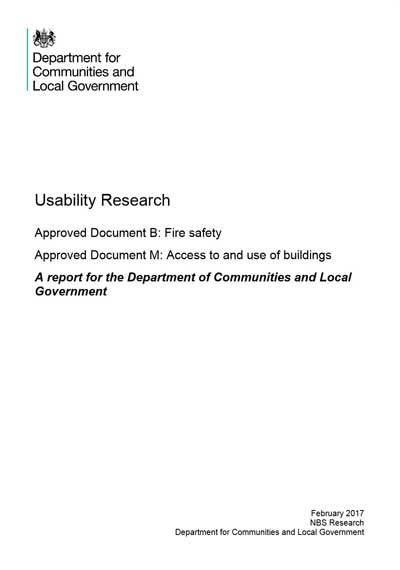Last year NBS Research, working with the Department for Communities and Local Government (DCLG), asked for your views on the Building Regulations Approved Documents (ADs).
 In particular:
In particular:
- Part B (Fire Safety) and
- Part M (Access to and use of buildings).
We were keen to find out what you thought of the usability of the Approved Documents with the aim of the study being to develop the style and format of future ADs to ensure they continue to be fit for purpose.
The research showed that the Approved Documents, including B and M, are essential in making sure people comply with the building regulations and that users value them.
While the documents are broadly fit for purpose now they will need to change as the construction industry embraces digital ways of working.
The study uncovered three distinct groups of users and makes six recommendations to make the Approved Documents easier to use and better able to effect compliance now and in the future.
The summary report is now available to download.
Thanks once again for your input if you took part in our survey.
The key findings
Who uses the Approved Documents?
The study found three core groups who make use of Approved Documents. These are:
1. Professionals involved with 'standard' buildings
This group are designing or advising on the construction of common building types, such as residential schemes, retail units, industrial units, and offices. The group includes: architects, building surveyors, engineers, and fire safety/access consultants, for example. Some contractors, too, fall into this group. This group are heavy users of the document and confident in using them. They rely on the ADs to tell them what to do to comply, and help others comply, with the Regulations. Therefore, they want clear, prescriptive guidance.
2. Professionals involved with 'non-standard' buildings
This group is made up of people who are involved with ‘non-standard’ complex buildings, such as high-rise commercial buildings, or unique public buildings. They are architects, engineers, fire safety and access consultants, and contractors – often from large firms. Building control officers and approved inspectors belong in this group too. They need technical detail for complex situations and typically turn to other sources for this, such BS 9999 or sector-specific guidance.
3. Small professionals and DIY-ers
Small builders and subcontractors working on projects like individual houses, shop fit-outs and extensions make up this group. They are not confident in their knowledge of the Regulations or the ADs, and they want to be told exactly what to do to comply.
Do people value the Approved Documents?
The Approved Documents are an essential resource relied upon by those who enforce the Regulations, advise on compliance or need to comply. They are valued and well used but people think they are complex and could be clearer. Users want clearer diagrams and pictures, and simpler language.
There is evidence of some uncertainty with the two-volume split of AD B and M assuming that Volume 1 (Dwellings/Dwellinghouses) covered only domestic work, and Volume 2 (Buildings other than dwellings/dwellinghouses) covered only non-domestic as is the case in Scotland.
There is a clear appetite for more prescriptive guidance and most believe it would increase certainty about compliance and make the criteria for building control officer and approved inspectors' decisions transparent.
Users also desire improved navigation and functionality and for referenced documents to be frequently updated to ensure they do not fall out of step.
While two thirds of respondents said they were broadly satisfied with the Approved Documents there is much that could be done to improve navigation and provide contextual information. The documents are suitable for the present but not for a digital future.
Six ways the Approved Documents could be improved
- The 'new style' should be applied to the remaining ADs. Larger diagrams, pictures and use of colours would also be useful.
- More prescriptive guidance should be included to make it clear what will comply and minimise the need for interpretation.
- Enhancements should be made to the .pdf versions of the ADs including hyperlinks, easier searching, cut and paste and updated links to documents referenced.
- Digital versions (HTML) should be developed. Likely features to include easier tailoring of guidance (domestic v non-domestic, standard v non-standard, prescriptive v non-prescriptive), updated links to referenced documents, printable sections and search across all documents with contextual results.
- Exploration of automated compliance checking and linking to BIMs.
- A review of the purpose groups in Approved Document B.


